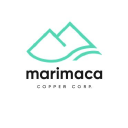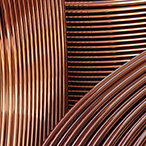Marimaca Copper Delivers Robust DFS Results with Strong Economics for 50,000 tpa Copper Project
.jpg)
Marimaca Copper's DFS shows US$587m capex, 31% IRR, and US$1.45/lb cash costs for 50ktpa copper production starting 2026 with 13-year mine life.
- Marimaca Copper's Definitive Feasibility Study confirms the Marimaca Oxide Deposit as a low-capital intensity copper development project with US$587 million pre-production costs and US$11,700 per tonne production capacity.
- The project delivers strong financial returns with a post-tax NPV8 of US$709 million and 31% IRR using conservative US$4.30/lb copper pricing, rising to US$1.07 billion NPV8 and 39% IRR at current market prices.
- Steady-state production targets approximately 49,000 tonnes per annum of Grade A LME copper cathode with competitive cash costs of US$1.68/lb and all-in sustaining costs of US$2.09/lb during years 2-10.
- The company has identified significant growth opportunities including untapped Inferred Resources, expansion potential at Pampa Medina and Madrugador deposits, and sulphide exploration possibilities.
- Environmental approvals are expected by end-2025 with construction targeting commencement in 2026, while debt financing discussions are progressing with advisors and technical experts engaged.
Marimaca Copper Corp., a dual-listed copper development company trading on the TSX (MARI) and ASX (MC2), has released the results of its Definitive Feasibility Study for the Marimaca Oxide Deposit in Chile. The company focuses on developing copper assets in the Atacama Desert region, with its flagship MOD project representing a key development opportunity in the global copper market. As copper demand continues to grow driven by electrification and renewable energy transitions, development-stage projects with robust economics and manageable capital requirements are increasingly attracting investor attention.
The DFS results position Marimaca's project among the lower-cost copper development opportunities globally, particularly for projects targeting production capacity above 50,000 tonnes per annum. The study encompasses a comprehensive technical and economic evaluation based on extensive drilling, metallurgical testing, and engineering work conducted over multiple years.
DFS Key Results & Capital Requirements
The Definitive Feasibility Study outlines a nominal 50,000 tonnes per annum copper cathode production target over an estimated 13-year reserve life. The project's pre-production capital cost estimate of US$587 million translates to a capital intensity of US$11,700 per tonne of copper production capacity.
President and CEO Hayden Locke emphasized the project's competitive positioning, stating:
"The DFS confirms the MOD's position as one of the most attractive copper development opportunities globally, especially when compared to those with a production capacity greater than 50ktpa. There are very few copper projects with lower capital intensity, and our competitive operating cost profile, positioned in the second quartile of Wood Mackenzie-benchmarked copper projects globally on an all-in-cost basis, drives superior return on invested capital metrics at virtually any copper price."
The capital cost estimate benefits from approximately 80% budget quotes, including an Engineering Procurement Construction quote for the solvent extraction-electrowinning plant. The study incorporates quotes from reputable equipment providers and large Chilean contractors with mining expertise, providing confidence in cost accuracy.
Financial Metrics & Economic Returns
The project demonstrates robust financial metrics across various copper price scenarios. Using a long-term copper price of US$4.30 per pound, which sits slightly below current consensus long-term pricing, the MOD delivers a post-tax net present value of US$709 million and internal rate of return of 31%. Pre-tax metrics show US$900 million NPV8 and 33% IRR.
At the three-month rolling average COMEX price of US$5.05 per pound, financial returns improve significantly to a post-tax NPV8 of US$1.07 billion and 39% IRR, with pre-tax figures of US$1.39 billion NPV8 and 43% IRR. The capital payback period is estimated at 2.5 years.
Locke highlighted the conservative pricing approach adopted in the base case analysis:
"Our base case economics are assessed using a flat long term copper price of US$4.30/lb, which is slightly below the current consensus long term price. We note other recent Feasibility Studies in our developer peer group have used a headline price of above US$4.80/lb. At that price, the MOD delivers nearly US$1bn of post-tax NPV8 with an IRR of 36.5%."
Operational Profile & Cost Structure
The operational design centers on a simple open-pit mining operation with an exceptionally low life-of-mine strip ratio of 0.8:1, including pre-stripped material. This low ratio contributes significantly to the project's competitive cost structure.
During the first five years of operation, the project targets 50,000 tonnes per annum copper production with estimated C1 cash costs of US$1.45 per pound and all-in sustaining costs of US$1.97 per pound. Steady-state production (years 2-10) is projected at approximately 49,000 tonnes per annum with C1 cash costs of US$1.68 per pound and AISC of US$2.09 per pound. Life-of-mine averages show C1 costs of US$1.84 per pound and AISC of US$2.29 per pound.
The processing approach utilizes three-stage crushing, agglomeration, and dynamic heap leaching with variable parameters depending on mineral sub-domains. Copper recoveries average 72% over the life of mine, with the first five years achieving 78% recovery rates based on comprehensive metallurgical testing programs.
Locke explained the operational advantages: "The MOD benefits both from its extremely low life of mine strip ratio, but also its geometry, which means even at the end of the current mine plan, the vertical haulage distance is less than 200m, meaning mining costs are significantly lower both on per tonne of material moved and per tonne of ore delivered to the heap leach pads."
Resource Base & Reserve Conversion
The project is supported by maiden Proven and Probable Mineral Reserves of 178.6 million tonnes with an average grade of 0.42% total copper, containing 750,000 tonnes of copper metal. These reserves are based exclusively on Measured and Indicated Resources, with Inferred material currently designated as waste in the DFS mine plan.
The resource base derives from approximately 140 kilometers of reverse circulation and diamond drilling completed between 2016 and 2022. The database incorporates sequential copper analysis, analytical acid consumption data, and detailed mineralogy studies.
An important aspect of the reserve conversion is the exclusion of 21 million tonnes of Inferred resources with an average grade of 0.29% total copper from the current mine plan. Locke noted the conversion potential: "The DFS excludes the inferred resources of 21Mt with an average grade of 0.29% CuT. Approximately 10Mt of inferred material is moved as part of the DFS mine plan, all of which reports to waste. We expect, with minimal additional drilling, that we can continue our strong conversion of mineral resources to ore reserves, which is approximately 84% for the Measured and Indicated resource categories."
Growth Strategy & Expansion Opportunities
Beyond the base case DFS, Marimaca has identified several growth vectors that could significantly expand production capacity and extend mine life. The company views the 50,000 tpa production target as a starting point for its organic growth strategy.
Key growth opportunities include the untapped Inferred Resources within the current MOD, the Pampa Medina and Madrugador Oxide deposits, and sulphide exploration potential at both Marimaca and Pampa Medina locations. Recent drilling success has demonstrated the sulphide potential below the MOD, which has never been systematically explored.
The initial design incorporates oversized key equipment and infrastructure to facilitate cost-effective future expansions, including the primary crusher, conveyors, water pipeline, power connections, and heap leach footprints.
Locke outlined the expansion vision:
"We are well progressed on a PEA for Pampa Medina, which has been briefly paused due to recent drilling success, and we now see strong potential to increase our production target scale from the contemplated 50ktpa of copper cathode production with oxides from the Pampa Medina and Madrugador deposits (although no forecast is made of that at this stage). We strongly believe 50ktpa of copper production is a starting point for the Company as we continue our journey towards being a significant global copper producer."
The company targets increasing potential production capacity to over 70,000 tonnes per annum of copper cathode within the next five years through development of these additional deposits.
Project Development Timeline & Permitting
Environmental permitting is progressing according to schedule, with the company having submitted responses to the first ICSARA (list of questions and clarifications) from regulatory authorities. Management anticipates one additional round of follow-up questions before environmental approvals can be granted.
Receipt of environmental approvals is targeted for the end of 2025, which would enable construction commencement in 2026. Following environmental approval, Sectoral Permits will be required to support full construction and operations phases.
Locke provided an update on the permitting timeline:
"Our permitting is progressing well and we have now submitted our responses to the first ICSARA (list of questions and clarifications) from the regulatory authorities. We expect one further round of follow-up questions and information requests after which the authorities should be in a position to provide environmental approvals for the MOD. We are targeting receipt of environmental approvals by the end of 2025, allowing construction to commence in 2026."
Financing Strategy & Market Positioning
Debt financing workstreams are underway with advisors and technical experts engaged. The company's objective is identifying preferred financing partners by year-end 2025, aligning with the environmental approval timeline.
The DFS incorporates purpose-built water infrastructure to mitigate risks associated with existing regional mine water infrastructure. Water and power infrastructure costs are structured on a Build Own Operate Transfer basis, reducing upfront capital requirements while reflecting ongoing operating costs.
Management believes opportunities exist to further optimize capital costs through alternative contracting strategies. Locke explained:
"The Company believes there is an opportunity to further optimize the capital cost by utilizing a hybrid contracting strategy."
Risk Factors & Technical Considerations
The project benefits from relatively low technical risk given its straightforward open-pit mining approach and conventional processing methods. The dynamic geo-metallurgical model is based on extensive testing across seven phases of metallurgical work, providing confidence in recovery projections.
Operating costs have been developed from first principles and incorporate equipment provider maintenance schedules over the full mine life. The simple mining geometry and low strip ratio contribute to cost predictability and operational efficiency.
The DFS mine plan does not consider selective mining of mineralogical domains, though natural selectivity occurs based on deposit geometry. Early production years will focus on green oxides (brochantite and chrysocolla), transitioning to enriched secondary sulphides and WAD material in later years.
For Investors
Marimaca Copper's Definitive Feasibility Study presents a compelling investment proposition in the copper development space, combining low capital intensity, competitive operating costs, and robust financial returns. The project's position in the second quartile of global copper projects on an all-in-cost basis, coupled with superior return on invested capital metrics, provides defensive characteristics across various copper price environments.
The 13-year reserve life, supported by significant untapped resources and identified growth opportunities, offers potential for production expansion and mine life extension. With environmental approvals targeted for end-2025 and debt financing discussions advancing, the project appears well-positioned for development execution.
For investors seeking exposure to copper development projects with manageable capital requirements and strong economics, Marimaca's MOD represents one of the more attractive opportunities in the current market. The combination of technical simplicity, favorable geology, and experienced management team provides confidence in project delivery, while the identified growth pipeline offers potential for value creation beyond the base case development scenario.
Analyst's Notes




Subscribe to Our Channel
Stay Informed























